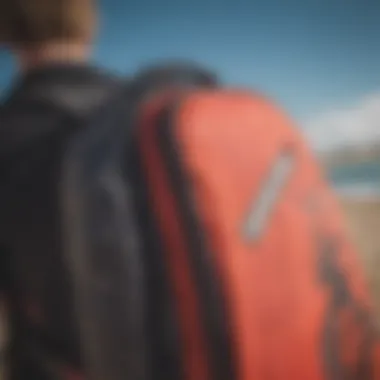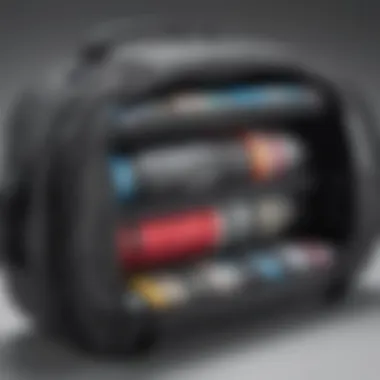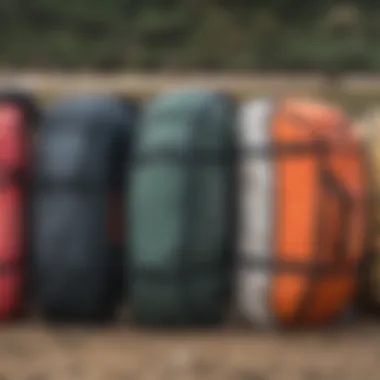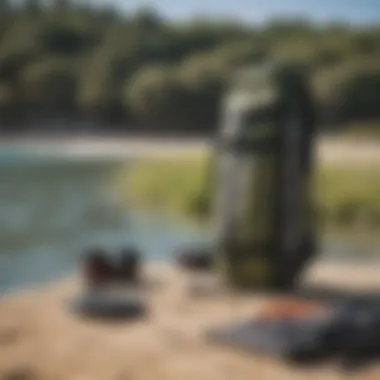Comprehensive Guide to the Dakine Kiteboard Bag


Intro
When it comes to kiteboarding, having the right gear is non-negotiable. Among the must-have accessories is a dependable kiteboard bag, and that’s where Dakine steps into the spotlight. This comprehensive guide will shed light on the features, materials, and advantages of the Dakine kiteboard bag, making it clear why this bag is both a savior of your gear and a facilitator of your performance.
Many kiteboarders know the frustration of packing up after a long day on the water, only to find that their gear has been scuffed or damaged. It’s enough to make you pull your hair out. A quality kiteboard bag is your best line of defense against these mishaps, ensuring your kiteboard and accessories remain in top-notch condition.
The guide also dives into comparisons with other brands, maintenance tips to prolong its lifespan, and insights into environmental practices within the kiteboarding community. With these aspects explored, kiteboarders from all walks, whether newbies or veterans, can find value in what this bag brings to the table. Let’s dive in and start by looking at important gear selection details that can impact your overall kiteboarding experience.
Gear Selection
Types of Kites
Kiteboarding demands a good understanding of the various types of kites available. These range from the more common inflatable kites to the specialized foil kites. Each type excels in different conditions, and choosing the right one depends largely on your skill set and the kind of riding you want to do.
- Inflatable Kites: Generally beginner-friendly and versatile. They provide stability and are easier to launch and land.
- Foil Kites: These require a bit more finesse to handle but offer impressive performance in light wind.
When selecting a kite, consider factors like wind conditions, skill level, and personal preference. A kite that works well for one chic seaside spot might bomb in another location with fickle winds.
Choosing the Right Board
Just like picking the right kite is crucial, so is selecting a board that complements your style. Remember, not all boards are created equal. Here are some things to keep in mind:
- Board Size: Bigger boards float better in light winds but can be clunky in high winds. On the other hand, smaller boards provide greater control and responsiveness in windy conditions.
- Board Shape: Different shapes affect speed and handling. A twin-tip board is ideal for beginners and can be used in both directions, while a directional board is typically favored by more experienced riders who enjoy surfing on the waves.
- Material: The construction material also plays a crucial role in performance and durability. Epoxy boards tend to be lightweight and more buoyant, while wood-core options offer better flex and feel.
Now that we've touched on the gear, understanding essential techniques is just as important in honing your kiteboarding skills.
Skill Development
Essential Techniques
Kiteboarding isn’t all about gear. Mastering essential techniques can make or break your experience on the water. Beginners should focus on practicing their launch and landing techniques, as these are fundamental skills that set the stage for advanced maneuvers.
As you advance, techniques like carving, jumping, and transitioning smoothly from one direction to another become key. Take your time with progressions, as skill building is a journey, not a race.
Progression Tips
For those looking to improve, here are some handy tips:
- Consistency is Key: The more time you spend on the water, the more comfortable you’ll get. Try to ride at least once a week.
- Learn from Others: Watching other kiteboarders can provide insights into techniques or styles that resonate with you.
- Don’t Rush: Progression takes time. Focus on mastering one skill at a time before moving to the next.
By investing in quality gear like the Dakine kiteboard bag and understanding the importance of gear selection alongside skill development, you set yourself up for success on the water.
"The right gear can change your kiteboarding experience from just another day at the beach to a thrilling adventure."
This guide aims to empower you on your kiteboarding journey, equipping you not just with the essentials of bag selection but also with strategies for progression and excellence. Understanding these components will enhance both your enjoyment and performance, ensuring that every session on the water is one to remember.
Prelude to Dakine Kiteboard Bags
In the realm of kiteboarding, where the thrill of carving through waves is met with the unpredictable nature of the ocean, the significance of proper gear cannot be overstated. One key component that has gained prominence among kiteboarding enthusiasts is the Dakine kiteboard bag. It serves as more than just a storage solution; it’s a protective sanctuary for your kiteboard and related equipment, ensuring durability and longevity despite harsh conditions. This article will delve deep into the intricate details of Dakine kiteboard bags, exploring their features, materials, and advantages. Plus, we will discuss maintenance tips and how to make the most of your investment.
Overview of Dakine as a Brand
Dakine has carved a niche for itself in the outdoor gear industry, offering products that embody quality, functionality, and style. Founded in 1979 in Hawaii, their pioneering spirit is evident in every product they create. The brand is known for their dedication to the action sports community, particularly among surfers, snowboarders, and kiteboarders. A name that carries the weight of trust and reliability, Dakine emphasizes performance-driven designs tailored to meet the needs of athletes and leisure enthusiasts alike.


Using high-quality materials and innovative technologies, Dakine delivers bags that not only showcase style but also prioritize functionality. Whether you're hitting the beach or traveling to a distant kiteboarding event, Dakine bags are designed to protect your gear while also making it easy to carry.
The Importance of Kiteboard Storage
Proper storage of kiteboarding equipment is crucial, yet often overlooked. An effective kiteboard bag does more than keep your board safe from the elements. It also helps prevent dings, scratches, and even potential breakage during transport. Kiteboards are an investment, one that deserves to be treated with utmost care. When not properly stored, they risk damage from environment factors and rough handling.
An appropriate bag, such as those from Dakine, contributes to optimizing the lifespan and performance of the board, giving it the respect it deserves.
- Key Considerations for Kiteboard Storage:
- Protection from External Elements: Prevent exposure to sun, salt, and moisture.
- Avoiding Physical Damage: Ensure there's padding to safeguard against bumps and rough handling.
- Organized Space: Having separate compartments for accessories like fins, harnesses, and lines can simplify the packing and unpacking process.
"> A quality kiteboard bag isn't just an accessory; it's a necessity for those serious about their sport. Protect your gear, enhance your performance, and ensure the longevity of your equipment. "
In sum, investing in a good kiteboard bag like those offered by Dakine is essential for any kiteboarder looking to preserve their gear while maximizing their time on the water.
Design Features of Dakine Kiteboard Bags
The design features of Dakine kiteboard bags are crucial for ensuring that your equipment remains in top shape, protecting it from potential damage that can occur during transport. Every kiteboarder knows that optimal performance in and out of the water starts with properly stored gear. With that idea in mind, Dakine has carefully crafted their bags to focus on durability, functionality, and user comfort—all vital elements for any passionate kiteboarder.
Construction and Materials
Dakine kiteboard bags are constructed with high-quality materials that stand up to the rigors of travel. Many bags are made using tough 600D or even 1000D polyester, which offers a good balance between weight and strength. These fabrics are intended to resist wear and tear, which is a common issue when hauling gear to various locations.
In addition to strong outer materials, numerous bags feature reinforced seams, providing additional strength where it’s needed most. Using waterproof zippers also enhances the overall durability of the bag, ensuring that any sudden downpours won’t ruin your equipment. The careful selection of materials means the bags not only endure but also expand the lifespan of the kite gear carried within.
Interior and Exterior Protection
Protection is par of the course with Dakine kiteboard bags. Inside, many models include padding that cushions your kite and board from impacts as they are jostled around during travel. This padding can make all the difference when you need to toss your bag into the back of a truck or a crowded airport.
On the outside, several bags are designed with additional protective features such as nylon reinforcements on the bottom, which is the most vulnerable area during transport. A great example of this design is the Dakine Concourse Roller Bag, which has a tough, molded bottom panel for added toughness. Additionally, some bags come equipped with a tarp lining, providing a waterproof barrier that also aids in cleaning up any inevitable spills of sand or saltwater that can occur.
Portability and Ergonomics
Considerations for portability permeate the design of Dakine’s kiteboard bags. Kiteboarders are often on the move, whether it be from the car to the beach or from country to country, so functionality is paramount. Many bags feature comfortable padded handles, allowing for easy carrying without straining your hands.
Moreover, wheeled bags like the Dakine Split Roller provide an additional level of convenience, making transport through airports or long stretches of sidewalk far less of a chore. The ergonomic strap designs mean you can haul heavier loads without feeling like you're about to break your back. Some bags even come with adjustable straps to help tailor the fit to the user’s preference, ensuring that every kiteboarder can find a bag that suits their individual needs.
The combination of thoughtful construction and smart design features in Dakine kiteboard bags not only protects your gear but also enhances your overall kiteboarding experience.
Comparative Analysis: Dakine vs. Other Brands
In the world of kiteboarding, having the right gear is crucial—especially when it comes to storage solutions like bags. Dakine has built a reputation for quality. However, it’s beneficial to explore the alternatives available. This comparative analysis sheds light on how Dakine measures against other brands, essential for making an informed decision.
Notable Alternatives in the Market
When considering kiteboard bags, several brands consistently come up in discussions among kiteboarding enthusiasts. While Dakine is well regarded, evaluating the competition can help to shape your perspective. Some notable alternatives include:
- Mystic: Known for their innovative designs, Mystic bags offer functionality without sacrificing style.
- North Kiteboarding: They provide a range of products that prioritize durability. Their kiteboard bags often come with added features for extra protection.
- Crazy Fly: This brand focuses on lightweight materials, making their bags easy to carry. A plus for kiteboarders who traverse long distances.
Each of these brands brings something unique to the table. Mystic's flair appeals to those wanting to make a fashion statement while ensuring their gear is safe. North Kiteboarding emphasizes robust construction, while Crazy Fly prioritizes ease of transport – an important factor for kiteboarders on the go.
Value for Money Considerations


The cost of a kiteboard bag is not just about the sticker price but also about its value in relation to its lifespan and performance. Here are some considerations:
- Durability: Investing in a Dakine bag might seem pricier compared to options from other brands, but their longevity can save you from frequent replacements. The high-quality materials mean you won’t be buying a new bag every season.
- Features: Look beyond the price tag. Dakine’s bags often include features like padded dividers that can protect your board. In contrast, some alternatives might skimp on padding to keep costs down.
- Warranties and Support: Many brands offer different warranties. Dakine often has a solid customer support options, providing peace of mind.
"A higher initial investment can lead to greater savings, both in terms of money and peace of mind."
Practical Usage of Dakine Kiteboard Bags
When it comes to kiteboarding, having the right gear can make a significant difference. The Dakine kiteboard bag plays a crucial role in protecting your investment and enhancing your overall experience on the water. Understanding the practicality of these bags goes beyond merely storing your equipment; it involves grasping the nuances of proper packing and transportation techniques that keep your kiteboard in ships-shape while you’re on the go.
Packing Techniques for Optimal Protection
Packing your kiteboard properly is essential for its protection during transportation. We want to keep those delicate edges and the graphics intact, right? Here are some key techniques to consider:
- Use Soft Inserts: Soft padded inserts are a game changer. They provide extra cushioning and absorb shock during transit. If you own multiple boards, it’s wise to keep them separated using these inserts.
- Secure the Fins Separately: Fins are delicate; ensure they do not rub against other hard surfaces. Store them in their dedicated pockets or wrap them in a soft cloth. It’s a small step that prevents big damage.
- Layer with Towels or Clothes: Get creative with your packing. Using towels or clothing to wrap your board adds an extra layer of protection against scratches or dings. This might sound basic, but it’s a tried-and-true method that many seasoned kiteboarders swear by.
- Tighten Straps Properly: Ensure that all straps are tight yet not overly so. This snugness keeps everything in place and reduces movement. A loose board bouncing around can lead to unwanted impacts.
Using these packing techniques effectively can prolong the life of your kiteboard and maintain its performance. A little attention to detail goes a long way.
Transportation: Best Practices
Once you've packed your kiteboard bag with care, it's critical to consider how to transport it safely, especially when traveling long distances. Here are some best practices:
- Choose the Right Vehicle: When possible, opt for a vehicle that allows for ample space. A hatchback or SUV allows you to lay your bag flat rather than propped up on its side, minimizing any potential pressure on your board.
- Protect from Elements: The weather can be unpredictable. If you're traveling in rain or snow, using a waterproof cover over your bag is a smart move. A simple garbage bag can work in a pinch, or invest in a dedicated waterproof cover.
- Be Mindful of Handling: When lifting your kiteboard bag, use your legs to lift, not your back. This keeps your equipment safe and helps prevent straining yourself. Moreover, try to avoid tossing your bag, as this might lead to internal shifting of your gear.
- Use Public Transport Wisely: If you're reliant on public transport, always be aware of your surroundings. Keeping your bag close and secure can guard against accidental bumps or even theft. Some experienced boarders use a luggage lock, but it’s not foolproof. Just stay alert.
"The essence of kiteboarding is not just in riding the waves but ensuring the safety of your gear while embracing adventure."
By adhering to these practical usage strategies, you ensure your Dakine kiteboard bag serves its purpose effectively, keeping your kiteboard protected and ready for when you hit the water again.
Maintenance and Care for Longevity
Taking care of your kiteboarding gear is not just a matter of vanity; it’s an investment in the longevity of your equipment. The Dakine kiteboard bag, crafted from quality materials and design, deserves the attention it needs to maintain its protective features and overall performance. Proper maintenance ensures that your kiteboard, bindings, and other accessories are shielded from the rigors of travel and environmental wear.
A well-maintained bag not only holds its value longer but also allows you to get the best out of your kiteboarding experience. If you neglect the bag, it could lead to frayed materials or compromised padding—defeating the very purpose of having a specialized kiteboard bag in the first place.
Cleaning Instructions
Keeping your Dakine kiteboard bag clean is essential for both aesthetics and longevity. Ideally, you should clean your bag after each trip, especially if you’ve been in sandy or muddy environments. Here’s how to do it:
- Remove all contents: Before cleaning, take out your kiteboard and all accessories to avoid damaging anything while cleaning.
- Shake it out: A quick shake will help you dislodge any loose sand or debris from the inside.
- Spot cleaning: For stubborn stains or fishy odors, use a damp cloth combined with a mild soap solution. Scrub the affected areas gently. Avoid harsh chemicals, as they might degrade the fabric.
- Rinse thoroughly: It’s important to rinse off any soap residue. You don’t want to leave any soap that might attract dirt in the future.
- Air dry: Hang your bag outdoors in a shaded area and allow it to air dry completely. Avoid direct sunlight as it can fade colors and weaken fibers over time.
"Routine care can save you from costly repairs or replacements down the line. Just a simple wash and a little attention can keep your gear as good as new."
Storage Recommendations
Where you store your Dakine kiteboard bag also plays a crucial role in its maintenance. Here are some guidelines:
- Dry location: Ensure that your storage area is dry to prevent mold and mildew from forming.
- Avoid extreme temperatures: Don’t store your bag in places with high heat or extreme cold—like a garage during winter or a hot attic. Fluctuating temperatures can warp shape and damage materials.
- Utilize garment bags or dust covers: If you're not using your bag for a while, consider placing it in a breathable dust cover to keep it clean and dust-free.
- Keep it off the floor: Elevating your bag on shelves or hooks can prevent it from getting damaged by dirt or water from the ground.
- Frequent checks: Periodically inspect your bag for any signs of wear or tear. Catching small issues early can save you from big problems later on.
Caring for your Dakine kiteboard bag isn’t just about following a checklist—it’s about respecting the gear that enables your kiteboarding adventures. By adhering to these cleaning and storage guidelines, you’ll ensure that your bag remains as trusted as a good friend on the water.
Environmental considerations in Kiteboarding Gear
In today's world, where climate change and environmental degradation are issues at the forefront of public concern, kiteboarding enthusiasts must also consider the ecological implications of their gear choices. The topic of environmental considerations in kiteboarding gear isn't just about personal responsibility; it reflects a broader movement towards sustainability in all outdoor sports. With kiteboarding becoming more popular, the industry faces the challenge of mitigating its impact on the environment while still delivering performance and protection that riders demand.


Sustainable Practices in Production
When it comes to kiteboarding gear, sustainability begins at the production stage. Companies like Dakine are increasingly adopting sustainable practices, which not only influence the planet but also appeal to the environmentally conscious consumer.
- Material Sourcing: The materials used in paddle bags, kite bags, and other accessories play a massive role in their environmental footprint. Many brands are shifting towards recycled materials, which reduces the demand for virgin resources. For instance, recycled polyester made from plastic bottles cuts down on waste and the fossil fuel consumption involved in using new materials.
- Responsible Manufacturing: Production processes that minimize water use, toxic substances, and energy consumption are becoming standard. Factories that meet specific environmental standards can reduce their overall impact, ensuring a cleaner environment.
- Eco-Friendly Packaging: Even packaging plays a part. Some brands are opting for biodegradable or recyclable packaging solutions to lower waste generated from shipping products.
Making informed choices about where and how gear is made can drive the entire kiteboarding industry towards a more sustainable direction. When consumers prioritize these sustainable practices, they encourage companies to continue innovating and changing their approach.
Recycling Kiteboarding Accessories
Recycling is a crucial component of reducing waste and ensuring that kiteboarding remains a sustainable sport. Numerous options exist for recycling kiteboarding accessories:
- Kite Recycling Programs: Some organizations offer recycling programs specifically for old kites, helping to transform them into new items rather than allowing them to end up in landfills. These initiatives can lead to valuable products that further support the sport while lessening environmental impact.
- Local Workshops: Riders can often find local workshops where they can donate or recycle used gear. This not only prolongs the life of various materials but also educates the community about sustainability and recycling.
- Upcycling: Some creative kiteboarding enthusiasts have taken it upon themselves to upcycle old gear into new functional items—everything from bags to wallets can be crafted from salvaged materials. This not only reduces waste but adds a unique flair to the gear used.
Incorporating sustainable practices and recycling into the kiteboarding lifestyle isn't an afterthought—it’s an essential part of the modern sport. As the community of kiteboarding continues to grow, embracing these principles will help ensure that the sport can be enjoyed for generations to come.
"Every little bit counts in sustainability; it's like dropping pebbles in a pond, each ripple spreads further than we can see."
Through both sustainable production and recycling efforts, kiteboarders can make a significant impact on protecting the environment they treasure so greatly.
User Experiences: Testimonials and Reviews
Understanding the real-world impacts of any gear is crucial, and kiteboarding is no exception. User experiences, specifically testimonials and reviews, shed light on how the Dakine kiteboard bag performs in various situations. When gear is put through its paces on wind-swept beaches or in transport to far-flung locations, the true value surfaces. These insights can serve as guiding beacons for potential buyers, revealing whether the investment in a Dakine kiteboard bag is truly worth it.
Feedback from the Kiteboarding Community
The kiteboarding community is tight-knit, and word spreads like wildfire. Feedback from fellow kiteboarders often holds more weight than the most polished marketing materials from brands. Many users emphasize how Dakine's kiteboard bags hold up under pressure, particularly noting the robust construction and thoughtful design.
- Durability: A frequent theme in testimonials is the durability of these bags. Many riders have shared tales of their bags surviving rough handling at airports and being tossed into the back of trucks without showing any signs of wear.
- Protection: Numerous reviews mention the padded compartments which offer excellent protection for equipment. "I've dropped mine off a loading dock, and everything inside stayed intact," one enthusiastic user recounted, demonstrating the bag's ability to safeguard valuable gear on those inevitable missteps.
- User-friendly features: Another recurring sentiment is the design features—like multiple pockets and adjustable straps. Many riders appreciate a well-thought-out bag layout, which makes it easy to grab essential gear without rifling through a chaotic jumble.
Feedback from the kiteboarding community not only painted a picture of satisfaction but also highlighted realistic expectations for those considering a purchase.
Analyzing Popular Opinions
Beyond individual testimonials, analyzing broader trends in kiteboard bag reviews offers a clearer picture of the Dakine product's standing. Here, statistics can be enlightening, reflecting overall customer satisfaction.
- Ratings: Across various platforms, the Dakine kiteboard bag generally receives high ratings, often hovering around 4 to 5 stars. This is significant as it indicates consistent positive experiences, resonating with a majority of users.
- Notable Mentions: Industry professionals and seasoned kiteboarders often cite Dakine bags in forums and discussions. On sites like Reddit and Facebook, users discuss specific features that stand out, such as water-resistance of materials, making the bag suitable for both on-the-beach storage and transport in rain.
- Constructive Criticism: Nothing is perfect; some users mention minor inconveniences like the weight of the bag itself when fully loaded. However, this often comes with a caveat, as they acknowledge that this is the price for added protection and durability.
"With a Dakine bag, you're not just getting a piece of luggage; you're investing in peace of mind while you’re out there chasing the waves."
In summary, the collective voices of the kiteboarding community emphasize confidence in the durability, design, and protective features of the Dakine kiteboard bag. Potential buyers can benefit greatly from these insights, guiding them in making informed choices while navigating the often overwhelming sea of options in the kiteboarding gear market.
Ending: The Dakine Kiteboard Bag Value Proposition
The Dakine kiteboard bag serves as more than merely a container for kiteboarding gear; it is a strategic asset that can significantly impact both performance and longevity. As kiteboarding continues to evolve, so do the requirements for effective gear storage and transportation. In this context, understanding the value proposition of the Dakine kiteboard bag becomes paramount for enthusiasts and professionals alike. Investing in quality gear is not just about purchasing equipment; it's about ensuring that your kiteboarding experience is unhindered by logistical challenges.
Summary of Key Advantages
When considering the Dakine kiteboard bag, several standout advantages come to light:
- Durability: Made from high-quality materials which withstand the rigors of travel and adverse weather conditions. This durability ensures protection against wear and tear, making it a reliable investment.
- Protection: With cushioned compartments and waterproof features, gear is safeguarded against impacts and moisture. This ensures that your kite and boards maintain their performance at peak levels, free from damage that could result from poor storage.
- Ease of Portability: Ergonomic designs that include comfortable carrying straps and wheels for easy transport make it an ideal choice for those who frequently travel to different kiteboarding spots.
- Organizational Features: Multiple compartments allow for neat and efficient packing, reducing the hassle of searching through a chaotic bag. Having a well-organized bag can make a world of difference when you're at the beach, trying to prep for a session.
These advantages not only simplify the experience of kiteboarding but also enhance the overall performance by focusing on efficient use and care of the equipment.
Future Trends in Kiteboarding Storage Solutions
Looking ahead, the landscape of kiteboarding gear storage is likely to change in several interesting ways. Continuing advancements in materials technology could lead to bags that are lighter yet even more durable than their predecessors. Imagine a kiteboard bag that not only protects gear effectively but also integrates smart technology, such as built-in sensors to monitor temperature and humidity, ensuring your equipment is always in optimal condition.
Furthermore, sustainability is gaining traction within the kiteboarding community. Expect to see more brands, including Dakine, leaning towards eco-friendly materials. This could involve using recycled plastics or implementing sustainable manufacturing practices for their products. A shift toward green practices will not only appeal to environmentally-conscious consumers but also contribute to the overall health of our planet.
In summary, the Dakine kiteboard bag is more than a mere accessory; it represents a critical component of the kiteboarding experience, blending protection with performance. As the sport evolves, so will the storage solutions that accommodate it, ensuring that enthusiasts can always be ready to tackle the waves.















